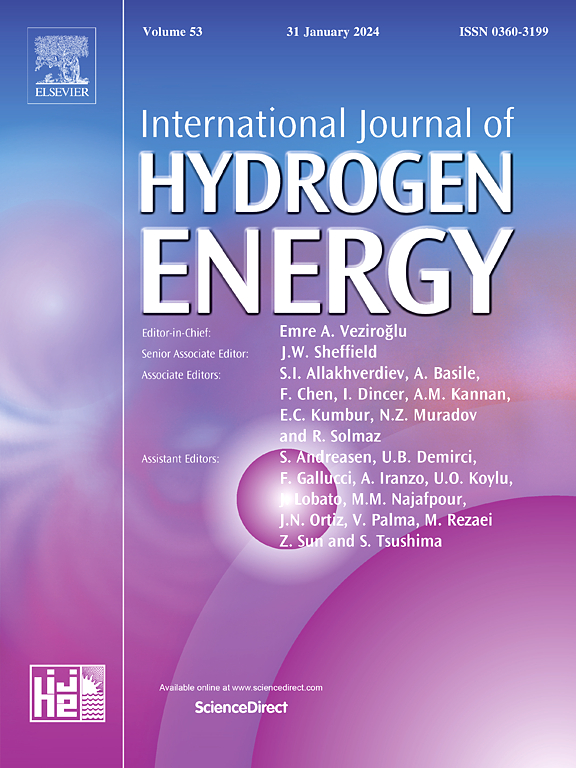揭示BiVO4中掺杂和固有空位在增强光电化学水分解中的作用:第一性原理研究
IF 8.1
2区 工程技术
Q1 CHEMISTRY, PHYSICAL
引用次数: 0
摘要
单斜型钒酸铋(BiVO4)具有良好的水氧化还原电位带对准、电荷提取效率高、易于合成等优点,是一种用于光电化学水分解的主要光阳极材料。然而,相对较宽的带隙、较低的电子导电性、较高的复合速率和缓慢的水氧化动力学阻碍了其光电化学性能。在这项研究中,我们使用密度泛函理论研究了非金属掺杂,以氮为模型,和本征空位(Bi, V, O)对BiVO4光催化性能的影响。氮掺杂使带隙减小了~ 0.3 eV,增加了载流子浓度,提高了迁移率,从而增强了电子-空穴分离。在本征缺陷中,氧空位对电荷输运的影响最为显著,而铋空位对光吸收的影响较大。一种电荷平衡的n掺杂BiVO4结构有效地结合了减少重组和改善光收获。我们的研究结果强调掺杂和空位的主要贡献在于增强光吸收和电荷分离,而不是注入效率。这些研究结果为合理设计先进的bivo4基光阳极以实现高效的光电化学水分解提供了有价值的指导。本文章由计算机程序翻译,如有差异,请以英文原文为准。

Unveiling the role of doping and intrinsic vacancies in BiVO4 for enhanced photoelectrochemical water splitting: a first-principles study
Monoclinic n-type bismuth vanadate (BiVO4) is a leading photoanode material for photoelectrochemical water splitting, owing to its favorable band alignment with water redox potentials, high charge extraction efficiency, and ease of synthesis. However, its photoelectrochemical performance is hindered by a relatively wide band gap, low electronic conductivity, high recombination rates, and sluggish water oxidation kinetics. In this study, we use density functional theory to investigate the impact of non-metal doping, using nitrogen as a model, and intrinsic vacancies (Bi, V, O) on the photocatalytic properties of BiVO4. Nitrogen doping reduces the band gap by ∼0.3 eV, increases charge carrier concentration, and improves mobility, leading to enhanced electron-hole separation. Among intrinsic defects, oxygen vacancies have the most significant effect on charge transport, while bismuth vacancies strongly influence light absorption. A charge-balanced N-doped BiVO4 structure effectively combines reduced recombination with improved light harvesting. Our results highlight that the main contributions of doping and vacancies lie in enhancing light absorption and charge separation, rather than injection efficiency. These findings provide valuable guidance for the rational design of advanced BiVO4-based photoanodes for efficient photoelectrochemical water splitting.
求助全文
通过发布文献求助,成功后即可免费获取论文全文。
去求助
来源期刊

International Journal of Hydrogen Energy
工程技术-环境科学
CiteScore
13.50
自引率
25.00%
发文量
3502
审稿时长
60 days
期刊介绍:
The objective of the International Journal of Hydrogen Energy is to facilitate the exchange of new ideas, technological advancements, and research findings in the field of Hydrogen Energy among scientists and engineers worldwide. This journal showcases original research, both analytical and experimental, covering various aspects of Hydrogen Energy. These include production, storage, transmission, utilization, enabling technologies, environmental impact, economic considerations, and global perspectives on hydrogen and its carriers such as NH3, CH4, alcohols, etc.
The utilization aspect encompasses various methods such as thermochemical (combustion), photochemical, electrochemical (fuel cells), and nuclear conversion of hydrogen, hydrogen isotopes, and hydrogen carriers into thermal, mechanical, and electrical energies. The applications of these energies can be found in transportation (including aerospace), industrial, commercial, and residential sectors.
 求助内容:
求助内容: 应助结果提醒方式:
应助结果提醒方式:


